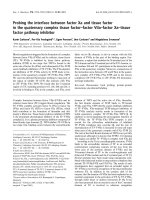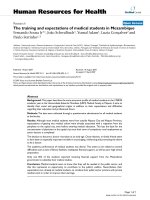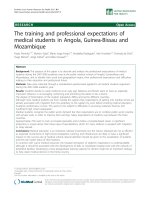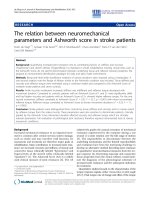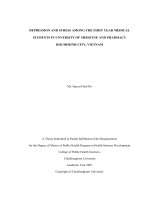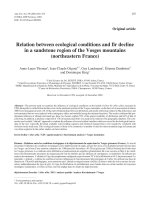“GREAT EXPECTATIONS”: COMMUNICATION BETWEEN STANDARDIZED PATIENTS AND MEDICAL STUDENTS IN OBJECTIVE STRUCTURED CLINICAL EXAMINATIONS
Bạn đang xem bản rút gọn của tài liệu. Xem và tải ngay bản đầy đủ của tài liệu tại đây (710.28 KB, 105 trang )
“GREAT EXPECTATIONS”:
COMMUNICATION BETWEEN STANDARDIZED PATIENTS AND MEDICAL
STUDENTS IN OBJECTIVE STRUCTURED CLINICAL EXAMINATIONS
Cynthia Lee Budyn
Submitted to the faculty of the University Graduate School
in partial fulfillment of the requirements
for the degree
Master of Arts
in the Department of Communication Studies,
Indiana University
November 2007
ii
Accepted by the Faculty of Indiana University, in partial
fulfillment of the requirements for the degree of Master of Arts.
______________________________
Stuart M Schrader, PhD, Chair
______________________________
Kim D White-Mills, PhD
Master’s Thesis
Committee _____________________________
Elizabeth M Goering, PhD
______________________________
Jane E Schultz, PhD
iii
ACKNOWLEDGEMENTS
I would like to thank my committee members for all of their help and support in
the completion of this degree. In particular, I especially thank my thesis chair, Dr Stuart
Schrader, for his unrelenting commitment to quality scholarship. Although at times I “just
wanted to be done,” I deeply appreciate his persistence in pushing me to re-examine,
rethink and rewrite so as to produce the best work possible. I feel as though I am already
reaping the rewards of the lessons in tenacity, persistence, learning and scholarship Stuart
has taught me.
I want to thank my committee members for their critical reflections of my work
and their help in teaching me the art of synthesizing my thoughts, constructing my
rationale, and articulating my ideas. In particular, I also thank my committee members for
their continued support and encouragement of me over these past two years.
I want to thank my friends and family for all of their support as well. Especially I
would like to thank my good friend, Dr Subah Packer, for all of the mentoring she has
given me over the years. Subah has been a role model for me in the hard work, high
ethical standards, and passion it takes to find happiness in both professional and personal
realms. I would also like to thank Sue Wheeler for her kind words, understanding, humor
and her ability to help me find perspective.
I also want to thank Dr. Deborah Griffith and Ms. Sara Highbaugh at the Clinical
Skills Education Center at the IU School of Medicine for their help during the initial
stages of this project. Sara’s willingness to allow me to perform as a standardized patient
across a variety of simulated exercises greatly helped me understand the benefits and
challenges of using standardized patients in medical education. Debi was an incredible
iv
help to me during the initial data-gathering stages of this project. Her willingness to allow
me to share my thoughts and feelings following my interviews and taped
encounters greatly helped me in later analyzing my data.
v
ABSTRACT
Cynthia Lee Budyn
“GREAT EXPECTATIONS”: COMMUNICATION BETWEEN STANDARDIZED
PATIENTS AND MEDICAL STUDENTS IN OBJECTIVE STRUCTURED
CLINICAL EXAMINATIONS
In relationship-centered care, the relationship formed between physician and
patient is critical to the creation of positive patient outcomes and patient satisfaction
(Inui, 1996; Laine & Davidoff, 1996; Tresolini, 1994). Medical educators have
increasingly utilized Objective Structured Clinical Examinations (OSCEs) to assess
medical students’ abilities to utilize a relationship-centered approach in clinical
interviewing. OSCEs, however, have recently come under scrutiny as critics contend that
the overly scripted and standardized nature of the OSCE may not accurately reflect how
medical students build and maintain relationships with patients. Although some studies
have looked at how standardized patients help teach medical students interviewing skills,
few studies have looked specifically at how the structured nature of the OSCE may
influence relationship-building between standardized patients and medical students.
Therefore, this study asks the question “How is relationship-centered care negotiated
between standardized patients and medical students during a summative diagnostic
OSCE?”
Using an ethnographic methodology (Bochner & Ellis, 1996), data consists of an
ethnographic field journal, transcripts of semi-structured interviews with SPs and medical
students, and transcripts of headache and chronic cough videotaped scenarios. Using
grounded theory (Strauss & Corbin, 1990, 1998), a back-and-forth thematic analysis was
vi
conducted in discovering the saturation of conceptual categories, linking relationships,
and in critically comparing interpretive categorical concepts with relevant literature
(Josselson & Leeblich, 1999).
Findings suggest that standardized patients and medical students hold differing
expectations for 1) diagnostic information gathering and 2) making personal connections
upon entering a diagnostic summative OSCE. SPs “open up” both verbally and
nonverbally when medical students “go beyond the checklist” by asking discrete
diagnostic questions and when overtly trying to connect emotionally. Fourth year medical
students, however, expect SPs to “open-up” during what they experience as a rushed,
time-constrained, and overly structured “gaming” exercise which contradicts their own
clinical experiences in being more improvisational during empathetic rapport building.
Differences between SPs and medical students’ expectations and communication
practices influence how they perform during summative diagnostic OSCEs. Findings may
suggest the re-introduction of more relationship-focused OSCEs which positions SPs as
proactive patients who reflexively co-teach students about the importance of making
personal connections.
Stuart M Schrader, PhD
vii
TABLE OF CONTENTS
Introduction 1
Rationale 5
Literature Review 9
Relationship-Centered Care: Physician-Patient Relationships
in Diagnostic Medical Interviewing 9
Standardized Patients’ Role in Teaching Relationship-Building 16
OSCEs Need a Relationship-Centered Lens 18
Methods 20
OSCE Performance Day 21
Grading IUSM OSCEs 25
Standardized Patient Recruiting 26
Standardized Patient Training 27
Research Design 29
Study Participants 31
Data Analysis 34
Results 36
“Great Expectations” in Diagnostic Information Gathering 36
“Great Expectations” in Making Personal Connections 50
Conclusion 73
Limitations 74
Future Research 75
viii
Applied Clinical Educational Implications 77
Re-structuring OSCEs as a More Relationship-Focused,
Less Scripted Diagnostic Clinical Interview 77
Appendix 83
References 85
Curriculum Vitae
1
INTRODUCTION
As medicine has increased in complexity, more attention has been paid to the
importance of physician-patient communication as a means to improve patient outcomes
and increase patient satisfaction (Tresolini, 1994). A century ago, when most people died
of acute infectious diseases such as influenza and tuberculosis, the most a physician could
offer her/his patient were a few encouraging words and possibly an herbal remedy to help
soothe her/his discomfort (Risse, 1999; Starr, 1982). Over the past century, however,
sanitation improvements and advances in technology and pharmacology have resulted in
patients living long enough to develop integrative and chronic diseases such as heart
disease and cancer (Risse, 1999; Starr, 1982). Therefore, diagnosis and treatment
planning have become increasingly complex and so too has the clinical conversation.
Clinical conversations often include physicians motivating patients to make lifestyle
changes (e.g., diet and exercise planning), explaining complex drug regimens and
coordinating treatment plans with other physician-specialists (Tresolini, 1994). Finally,
clinical conversations have become increasingly complex as physicians and patients
negotiate with healthcare insurance companies who take part in deciding treatment
coverage (Friedenberg, 2000).
Diagnosing and treating complex chronic diseases within a managed care system
has put tremendous pressure on physicians to be proficient in biomedical sciences,
technical clinical problem-solving, behavioral sciences and communication skills, all in
order to create positive clinical health outcomes (Smith, 1996; Williams, Frankel,
Campbell, Thomas, & Deci, 2000). In turn, studies have shown that effective physician-
patient communication results in increased patient satisfaction (Laine & Davidoff, 1996;
2
Larivaara, Kiuttu, & Taanila, 2001; Stewart, Brown, Donner, McWhinney, Oates,
Weston, et al., 2000), decreased “doctor-shopping” (Lo, Hedley, Pei, Ong, Ho, Fielding,
et al., 1994), and reduced malpractice litigation (Levinson, 1994). As a result, teaching
physician-patient communication has become increasingly important in medical
education over the past several decades. Medical schools have introduced various
teaching and learning techniques into their curricula that aim to help students learn
communication skills. For example, in many medical schools, students discuss and
reconstruct actual cases to help them learn how communication with the patient and her
family plays an important role in diagnoses and treatment (Chapman, Westmorland,
Norman, Durrell, & Hall, 1993). Medical schools also extensively use standardized
patients (SPs) in formatively and summatively assessing students‟ abilities to effectively
communicate during medical interviews. National board examinations as of 2005 even
required all medical students to successfully pass a rigorous Objective Structured Clinical
Examination (OSCE pronounced OS-KEE) using standardized patients.
In order to directly learn more about how medical students are trained about
communication skills, I engaged in a two year participant observation with standardized
patients at Indiana University School of Medicine‟s Clinical Skills Education Center.
Standardized patients are trained educator-actors who portray patients and/or patient‟s
family members across a variety of clinical settings (Barrows, 1993; Wallace, 1997). In
the mid 1960s, Barrows and Abraham (1964) were the first to introduce the idea of using
standardized patients so that medical students could practice their clinical and
interviewing skills before interacting with real patients. Standardized patients provided a
way to help teach medical students about physician-patient relationships and
3
communication without risking patient‟s safety and privacy (Wartman, 2006). Since that
time, the use of standardized patients in medical schools has increased across North
America and the world (Hodges, 2003a, 2003b). I participated in nearly all of the typical
activities of a standardized patient including the assessment of medical students as they
learn how to effectively diagnose, break bad news, gain informed consent, and practice a
physical examination.
The main focus of this research study involves exploring relationship-building
between standardized patients and fourth year medical students during Objective
Structured Clinical Examinations. In the late 1970s, Harden (Harden & Gleeson, 1979)
developed the idea of using standardized patients in OSCEs to assess clinical
interviewing skills. In OSCEs, students typically rotate between six to twelve case
scenario stations with standardized patients who are presenting different predetermined
sets of symptoms (e.g., depression) (Charlin, Tardif, & Boshuizen, 2000). Each encounter
is timed and lasts between 10 to fourteen minutes (Barrows, 1993). The value in using
standardized patients in OSCEs is threefold. First, standardized patients are expected to
perform the same role in the same way with all medical students (Barrows, 1993;
Barrows & Abraham, 1964). Standardization of the standardized patient‟s performance is
intended to eliminate evaluation rater bias which is inherently understood to exist in
traditional clinical interviewing evaluations using subjective faculty assessments of
student performance (Barrows, 1993; Barrows & Abraham, 1964). Second,
standardization and inter-rater reliability training allows for standardized patients to
accurately and consistently complete checklisted assessments to rate medical students‟
performances (Diaz, Bogdonoff, & Musco, 1994; Harden & Gleeson, 1979). During
4
inter-rater reliability training, standardized patients rate each other as they take turns
performing their case with an expert clinician. Standardized patients then compare scores
and make decisions regarding how to score consistently. Third, standardized patients
provide medical students with verbal and written feedback regarding how they felt the
medical student did in effectively asking clinical questions, and in gathering medical,
family and social history (Clark-Ucko, 2006; Wartman, 2006).
Medical students are often assessed using objective skill-based quantitative
checklist rating forms that measure a medical student‟s ability to ask a series of a priori
interviewing questions and/or nonverbal actions (Resnick, Blackmore, Dauphinee,
Rothman, & Smee, 1996; van der Vleuten & Swanson, 1990; Wagner & Heslop, 2002;
Wallace, 1997). OSCE evaluation instruments typically measure student effectiveness by
using binary (“yes/no”) question items, a few global rating scale questions (e.g., “The
medical student put me at ease”), and one or two qualitative open-ended questions to
assess more subjective communicative abilities such as rapport building, listening and
empathy (Wagner, Lentz, & Heslop, 2002; Wallace, 1997). OSCE evaluation instruments
may be completed by preceptors (i.e., physicians as expert raters), standardized patients,
medical students or by any combination (van der Vleuten & Swanson, 1990; Wagner &
Heslop, 2002).
The use and importance of OSCEs in medical education increased significantly in
2005 when the National Board of Medical Examiners (NBME) began requiring medical
students in their fourth and final year of medical school to pass a clinical OSCE
examination to become a licensed physician (National Board of Medical Examiners,
2007). Students take the exam at one of seven national testing sites. Chicago is the closest
5
testing site for Indiana University School of Medicine (IUSM) students. Students pay
approximately $1000 for the examination plus travel and lodging expenses. The national
exam is a 12-station OSCE graded on a pass/fail basis using highly standardized
objective rating checklists (National Board of Medical Examiners, 2007). The NBME
estimates that approximately 4% of students fail the exam each year (National Board of
Medical Examiners, 2006). The overall purpose of the national OSCE examination is to
detect students who do not meet minimum communication and cognitive skills standards
(National Board of Medical Examiners, 2007). The national exam includes three sub-
components which require the standardized patient to test the medical student on her/his
ability to gather and document information (Integrated Clinical Encounter
Subcomponent), build rapport, question and share information while maintaining a
professional manner (Communication and Interpersonal Skills Subcomponent) and speak
English clearly (Spoken English Proficiency Subcomponent). The influence of the
national exam has caused medical schools to introduce the use of SPs earlier on in
medical education and to begin requiring students to pass more comprehensive rigorous
summative OSCE examinations as part of graduation requirements. Therefore, at IUSM,
medical students at the beginning of their fourth year take a seven-station OSCE
examination in preparation for the national OSCE.
Rationale
Reconstructing the OSCE to reflect students‟ skills in relationship-building.
Despite its widespread use internationally as an assessment of medical students‟ clinical
interviewing skills, the OSCE has come under scrutiny in recent years. The OSCEs
emphasis on standardization and high stakes assessment can likely increase inter-rater
6
reliability. However, can this same process accurately reflect how medical students
and/or physicians interact with real patients? In addition, the checklisted assessment tools
typical may not effectively assess medical students‟ competence in building relationships
(e.g., rapport) with patients.
Hodges (2003) contends that the emphasis on “standardization” within OSCEs
has resulted in the creation of overly generalized and decontextualized medical scenarios
which create seemingly unfamiliar and/or unrealistic working situations for medical
students. For example, many OSCE cases do not integrate a team-based practice and
group discussion model in simulated encounters, even though medical students are
consistently trained to treat real patients from an integrative team-based approach.
In addition, Hodges (2003) contends that high-stakes summative or licensure
examinations may result in students conforming to mainstream cultural and interpersonal
expectations during the examination which may differ from how they may interact with
“real” patients. Hodges (2003) provides the example of a Muslim woman he observed
performing in a Canadian licensure OSCE. The scenario was scripted so that the female
Muslim doctor was to interact with a white, male western pharmacist (the actor) who
refused to give the doctor the morning-after pill for a patient. During one point in the
encounter, the female Muslim doctor says to the pharmacist standardized patient, “It is
not really life, it is just a ball of cells. It is not life. There is no problem. Please just give
[the patient] the pills” (Hodges, 2003, p. 1136). Hodges‟ (2003) observation of this case
caused him to consider how larger sociopolitical influences (i.e., becoming licensed as a
medical doctor) may influence how students perform their roles with standardized
patients. Hodges (2003) states, “I wondered what the woman really believed. Was this
7
how she would perform „in the real world‟? What was the effect of the white, male,
western actor pretending to be a pharmacist? What was the effect of the white, female,
western doctor grading her performance?” Hodges (2003) contends that the high-stakes
nature of the examination may have influenced the female Muslim student to perform her
role in a way that is consistent with North American culture and therefore deemed
“correct” by her white male examiner. Hodges‟ (2003) concern is that the high-stakes
nature of the OSCE does not allow students the freedom to express how their cultural
differences may influence how they interact with the patient.
Also, the checklisted assessment may not capture medical students‟ abilities to
build and maintain relationships with patients. Students‟ clinical medical and
communication competence has traditionally been based upon the number of checklisted
items they accomplish during the encounter. These checklisted items include mostly
binary (“yes/no”) questions which are directly presumed to causatively lead to a correct
differential diagnosis (e.g., The medical student asked me about my family history of
cancer). Therefore, they will immediately know to travel down this differential diagnostic
path. Only a few global rating scale items pertain to the medical student‟s communication
and interpersonal skills (e.g., Did the medical student demonstrate empathy in discussing
miscarriage?) Because most checklist OSCE assessments were developed during a time
when positivist views dominated social science (Hodges, 2003b), a medical student was
thought of as “competent” at clinical interviewing if she/he could ask the most salient and
directed biomedical questions in order to obtain a correct diagnosis. One concern is that
medical students may be rewarded with good marks on OSCE exams for communication
content (e.g., asking specific questions), yet still not know how to build, maintain or
8
sustain relationships with patients (Schirmer, Mauksch, Lang, Marvel, Zoppi, Epstein,
Brock, & Pryzbylski, 2005).
Because OSCEs may only partially reflect how medical students interact with
patients, Hodges (2003) suggests that studies need to examine the communicative
practices and processes between standardized patients and medical students to better
understand how OSCEs may or may not reflect medical students‟ relationship-building
skills with patients. Although a few studies have looked at the standardized patient‟s role
in helping medical students learn to build physician-patient relationships, few studies
have looked specifically at the negotiation of relationships between standardized patients
and medical students while performing in a summative OSCE. The purpose of this study,
therefore, is to examine the negotiation of relationships between standardized patients
and medical students.
9
LITERATURE REVIEW
This research study builds on the conceptual framework of relationship-centered
healthcare (Tresolini, 1994) in recognizing and appreciating the importance of effective
physician-patient relationships as a means to producing positive clinical interviewing
outcomes (e.g., increased rapport, empathy, support, warmth). Because this study
specifically explores the negotiation of relationships between standardized patients and
medical students performing in a diagnostic summative OSCE, the first section within the
literature review begins with an explanation of the importance of physician-patient
relationships in diagnostic medical interviewing. The next section addresses the
standardized patients‟ role in teaching medical students about relationship-building
during standardized patient encounters. Finally, this section ends by exploring the
usefulness of using a relationship-centered approach to gain insight into the negotiation
of relationships between medical students and standardized patients while performing in
a diagnostic summative OSCE.
Relationship-Centered Care: Physician-Patient Relationships in Diagnostic Medical
Interviewing
Relationship-centered care is currently one of the most widely accepted
conceptual frameworks for creating and maintaining physician-patient relationships in
clinical practice (Inui, 1996; Laine & Davidoff, 1996; Tresolini, 1994; Williams, Frankel,
Campbell, & Deci, 2000). The main tenet of relationship-centered care is that the
relationship formed between physician and patient is critical to the creation of positive
patient outcomes (e.g., correct diagnosis) and patient satisfaction (Inui, 1996; Laine &
Davidoff, 1996; Tresolini, 1994). Positive physician-patient relationships are defined as
10
an increased trust between physician and patient, patients‟ greater willingness to share
their story, and patients‟ greater adherence to recommended treatments (Inui, 1996;
Tresolini, 1994).
According to relationship-centered care scholars, “All illness, care and healing
processes occur in relationship” (Beach & Inui, 2006, p. S3) such that the task
dimensions of diagnosing and treating patients are inseparable from the quality of
relationships formed between physicians and patients (Candib, 1995; Zoppi & Epstein,
2002). Physicians skilled at relationship-building build rapport and trust with patients
which, in turn, allows patients to feel more comfortable sharing information with their
physicians (Tresolini, 1994; Williams, Frankel, Campbell, & Deci, 2000; Zoppi &
Epstein, 2002). For example, a physician skilled at relationship-building may elicit a
patient‟s story containing information which may lead the physician to a diagnostic
hypothesis she/he may not have considered on her/his own. Furthermore, when a
foundation of trust and rapport is established within diagnostic clinical interviews,
physicians are better able to negotiate treatment planning specific to the patient‟s needs,
which in turn improves the patient‟s adherence to recommended treatments (Tresolini,
1994). For example, if a patient who recently has been diagnosed with diabetes feels as
though all of her/his questions and concerns have been heard, addressed and understood
by her/his physician, she/he is more likely to adhere to the physician‟s recommendations
for medication, diet and exercise.
This next section addresses the following elements that contribute to the
development of effective physician-patient relationships in clinical diagnostic medical
interviews such as the physician‟s ability to: (1) make a personal connection with the
11
patient, (2) appreciate and understand the contextualized nature of their clinical
encounter, (3) implement flexible and improvisational communication styles, and (4)
appreciate nonverbal language as being powerfully influential in determining
conversational flow, direction and meaning.
Physician‟s ability to make a personal connection with the patient. Relationship-
centered healthcare scholars contend that a physician‟s ability to make a personal
connection with the patient has practical implications for gathering diagnostic
information (Beach & Inui, 2005; Candib, 1995; Matthews, Suchman, & Branch, 1993;
Suchman & Matthews, 1988). A personal connection between the physician and patient
has to do with the patient feeling as though her/his physician is genuinely concerned
about her/his subjective illness experience. A physician making a genuine effort to
construct a personal connection with a patient is more likely to anticipate and ask about
elements of the patient‟s subjective illness experience that may affect her/his diagnosis
(Beach & Inui, 2005; Candib, 1995; Matthews, Suchman, & Branch, 1993). The
physician‟s commitment toward appearing genuinely caring and concerned is then
expressed in tandem by the physician not simply asking a series of diagnostic questions
in a static way, but instead conducting the clinical interview in a way that shows that the
physician is attentive, inquisitive and responsive to the patient‟s answers and
interjections. A personal connection formed between the physician and the patient
becomes apparent as the patient becomes more willing to “open up” and discuss her/his
physical symptoms and concerns.
Appreciation for the contextualized nature of the encounter. A physician‟s
appreciation for the contextualized nature of the encounter is also important in
12
relationship-building during diagnostic clinical interviews. Physicians who appreciate
clinical conversations as not simply occurring in a decontextualized vacuum as back-and-
forth exchanges of information between physician and patient, but instead as highly
integrated systems (Frank, 1995; Inui, 1996; Tresolini, 1994), are more likely to remain
attentive to the patient while simultaneously taking into consideration other
contextualized factors. Physicians skilled at relationship-building recognize how the
context of the encounter may change how they decide to begin the interview, order and
re-order questions, and adapt their nonverbal affect to meet the patient‟s state of mind
(Charon, 2001; Massad, 2003). For example, a physician interviewing an under-insured,
high-risk, single parent obstetrics patient may spend a considerable amount of time
discussing how the patient may best be able to balance her work-related demands with
taking preventative measures (e.g., bed rest) to increase her chances for a full term
pregnancy. By adapting the conversation to recognize and address a patient‟s specific
needs, the physician gathers information which may help her/him in tailoring a treatment
plan specific to the patient. Additionally, the relationship between the physician and the
patient is also strengthened because the patient feels trust in her/his physician.
Implementing flexible and improvisational communication styles. Relationship-
centered care scholars suggest that strong physician-patient relationships are built when
physicians can implement flexible and improvisational communication styles. Because
patients often tell stories in fragmented and disjointed ways (Hurwitz & Greenhalgh,
2001), physicians must be skilled at navigating a patient‟s complex story so that it makes
sense to both the patient and the physician. Specifically, obtaining diagnostic information
from patients involves actively listening to the patient‟s multiple concerns, deciding
13
which of those concerns to explore with more specific and directed questioning, and then
synthesizing that information with their biomedical and psychosocial knowledge in
developing a differential diagnosis (Frank, 1995; Inui, 1996; Tresolini, 1994).
Scholars contend that developing qualities such as mindfulness may help in
flexibly communicating with patients (Epstein, 1999; Novack, Epstein, & Paulsen, 1999).
Mindfulness has to do with remaining meta-aware in the moment of how the interaction
between themselves and the patient influences the direction and flow of the conversation
(Epstein, 1999; Novack, Epstein, & Paulsen, 1999). Epstein (1999) suggests that when
skilled physicians think of themselves as both “participant and observer” within the
medical interview, they maintain a position from which to listen and respond to the
patient‟s story while remaining critically aware of how the conversation may need to be
redirected to best meet the patient‟s needs.
Other scholars such as Charon (2001), Hurwitz (2001), and Greenhalgh and
Hurwitz (1999) add that physicians best build relationships when they adopt a flexible
construct in thinking about medical interviewing. Skilled physicians may build
relationships with patients by also being “narratively competent” (Charon, 2001) or by
having a “narrative appreciation” (Hurwitz, 2000; Greenhalgh & Hurwitz, 1999) for the
clinical interview. From this view, skilled physicians allow the patient to tell her/his own
story. The physician makes sense of the patient‟s story within the clinical conversation
and during the patient charting process by delineating and categorizing salient characters,
plotlines, settings, themes and sub-themes as a narrative technique in taking a more
biopsychosocially comprehensive and holistic social and medical history (Charon, 2001;
Hurwitz, 2000). The physician views the clinical interview as the creation of a “third”
14
story which resides neither with the physician nor with the patient, but instead is a unique
and mutually constructed “joint narrative” (Brody, 1994, 1995).
Massad (2003) and Neuwirth and Schrader‟s (2004) “performance” perspective
on “doctoring” emphasizes that skilled physicians may improvise “between” the scripts
of negotiating biomedical information and sharing about the patient‟s illness experience.
According to Massad (2003), skilled physicians implement flexible communication styles
by critically “…valuing and responding to what is going on between patient and
physician [within] the relationship-building process (and how that process contributes to
outcomes)” (p. 11). For example, an experienced physician and an inexperienced
physician may diagnose differently after interviewing the same patient. The two
physicians may follow similar deductive diagnostic algorithms in determining a
diagnosis. However, when and how each physician asks questions and/or invites the
patient to share her/his story may vary considerably. The inexperienced physician will
most likely ask a series of highly structured closed-ended diagnostic questions (Haber &
Lingard, 2001). However, the experienced physician will be better equipped to flexibly
and creatively adapt the timing and phrasing of more open-ended questions. The
experienced physician‟s ability to do so most likely will create a stronger rapport with the
patient and increase the likelihood that the patient will disclose more personal,
biomedical, social and family history information. Neuwirth and Schrader (2004) suggest
that skilled physicians are analogous to a skilled “soloing” jazz musician who makes
momentary and spontaneous musical alterations while remaining in rhythm with the
song. In as such, young and inexperienced physicians are similar to novice jazz musicians
who are still “learning the notes” of the diagnostic song. Even though these scholars vary
15
somewhat in their specific perspectives, all agree that relationship-building within
diagnostic medical interviews requires physicians to adapt a flexible communication style
that allows them to improvisationally navigate the patient‟s story so as to assist in the
forming of a cogent evidence-based diagnosis.
Nonverbal language is powerfully influential in building and maintaining
relationships. Nonverbal language, in concert with verbal content, is powerfully
influential in relationship-building between physicians and patients. Shotter and Katz
(Katz & Shotter, 1996, 2000; Shotter, 1995, 1999, 2003; Shotter & Katz, 1998) suggest
that there are organic, spontaneous, and improvisational moments within the clinical
encounter that help shape and direct clinical conversations which, in turn, shape
relationships between physicians and patients. These verbal and non-verbal relational
“clinical moments” can be recognized in changes in intonation or a sudden aversion of
eye contact. These moments, hopefully when noticed, “call out” to the physician that the
patient may want, for instance, to redirect the conversation, share a part of her story, or
ask a question (Katz & Shotter, 1996, 2000; Shotter, 1995, 1999, 2003; Shotter & Katz,
1998). These “moments” or “gaps,” if missed in the conversation, reciprocally influence
the conversation between the physician and the patient (Katz & Shotter, 1996, 2000;
Shotter, 1995, 1999, 2003; Shotter & Katz, 1998).
Relationship-centered care scholars contend that a well-timed empathetic
response may positively influence how the patient shares about feeling understood,
relaxed, and connected with her physician, whereas ignoring the patient‟s actions and
invitations to become more empathetic (“gaps”) may make her feel misunderstood and
therefore distrustful of her physician (Coulehan, Platt, Egener, Frankel, Lin, Lown, &
16
Salazar, 2001; Roter, Frankel, Hall, & Sluyter, 2005; Zoppi & Epstein, 2002). For
example, while taking a medical history, a physician may be able to encourage a patient
to amplify her/his concerns by noticing and taking advantage of an inviting moment to
say to the patient, “You seem a bit concerned. Would you like to talk about it?”
(Coulehan, Platt, Egener, Frankel, Lin, Lown, & Salazar, 2001). Asking a question like
this could lead the standardized patient to share a piece of information about her/his
symptoms or family history that could lead the conversation in a different diagnostic
direction.
Standardized Patients‟ Role in Teaching Relationship Building
Standardized patients can help teach medical students to conduct medical
interviews from a relationship-centered care approach. Standardized patients assist in
teaching medical students to effectively integrate the biomedical and humanistic elements
of a diagnostic interview. In the two pre-clinical years of medical school, the
standardized patient is often the first “real” person that the medical student interviews in
obtaining a medical, family or social history. These experiences typically come in the
form of either formative (ungraded) OSCEs or other course-situated medical interviewing
skills training exercises. During formative OSCEs, standardized patients typically give
medical students oral feedback regarding how the standardized patient felt during the
encounter. Oral feedback is typically not provided during summative OSCEs. However,
standardized patients are often allowed to make written qualitative comments in the space
provided at the bottom of their checklist. The literature also suggests that standardized
patients provide feedback about how the medical student made the standardized patient
feel during the encounter.
17
Most standardized patient literature focuses on the standardized patient‟s role in
teaching medical students about how specific language choices may affect their
relationship with the patient (Barrows, 1993; Clark-Ucko, 2006). For example,
standardized patient literature addresses such topics as how well the medical student
opened the encounter, built and maintained rapport with the patient, and phrased
biomedical questions so as to effectively elicit integrative biopsychosocial information
(Barrows, 1993; Barouch, 2007; Clark-Ucko, 2006; Diaz & Bogdonoff, 2004; Wagner,
Lentz, & Heslop, 2002). In addition, standardized patients may tell medical students that
opening the interview by shaking hands with the patient and then asking her/him how
she/he would like to be addressed (e.g., “Ms Smith, how would you like for me to address
you?”) helps to show respect for the patient. Additionally, standardized patients may
advise medical students that asking the patient about her/his life and interests going
beyond the biomedical issues at hand (e.g., family, community activities, hobbies) helps
to build rapport at the onset of the encounter. Finally, standardized patients may advise
medical students to be mindful in how they phrase diagnostic questions (Barouch, 2007;
Clark-Ucko, 2006). Standardized patients may warn medical students to not ask questions
that are leading, contain medical jargon, or are compounded in nature because these types
of questions may leave the patient feeling confused, misunderstood and even
depersonalized. For example, a standardized patient may give a medical student feedback
to be careful not to say “So you don‟t drink?” because it may influence the patient to
answer the way she/he thinks is “appropriate.” Standardized patients may also give
medical students feedback suggesting that they avoid the use of medical jargon when
talking to patients because patients may not understand what the physician is trying to ask


